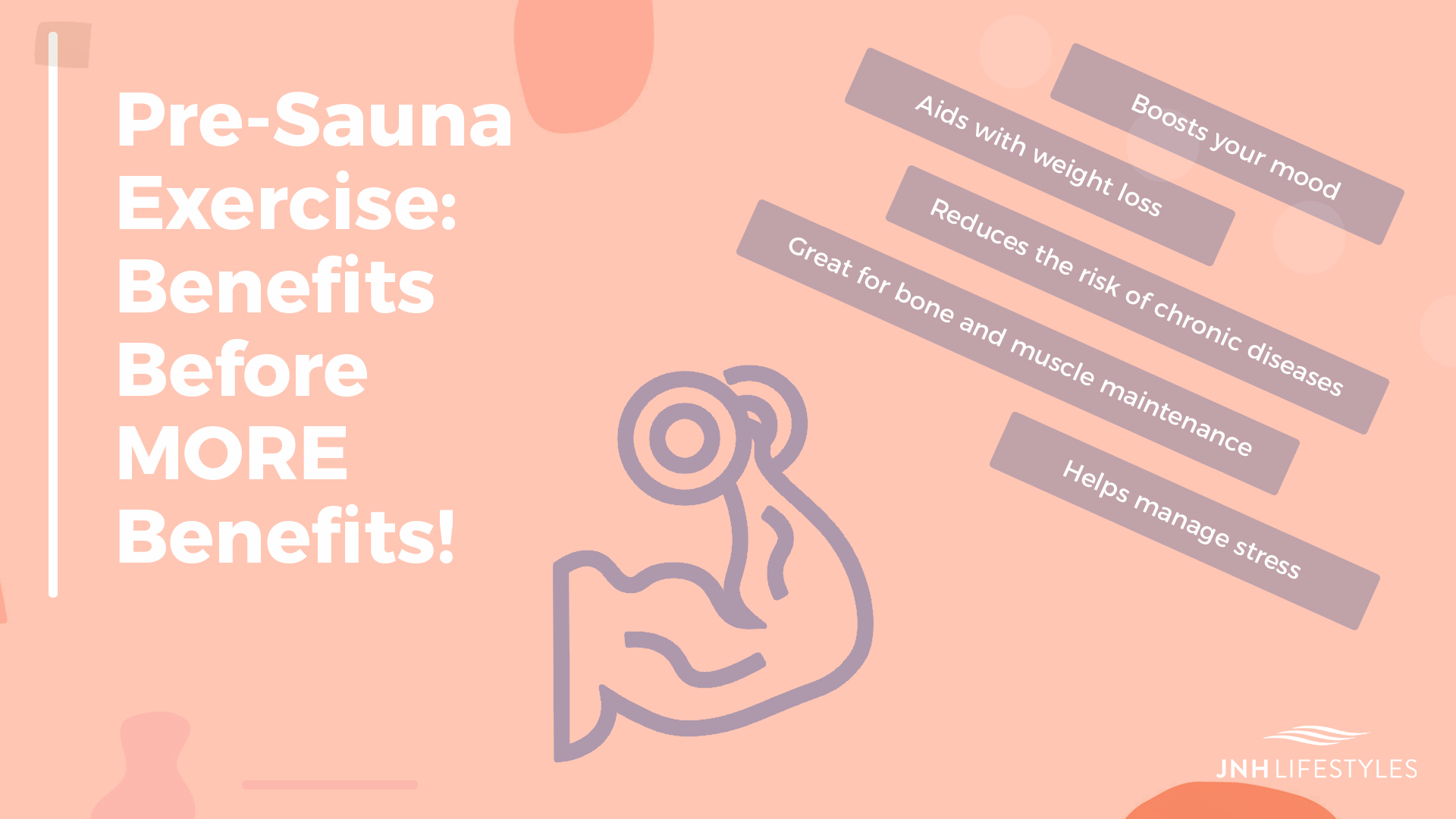The Benefits of Working Out Before an Infrared Sauna Session
Working out has never been more important than today. With increased pollution, compromised immune systems and an unhealthy lifestyle, medical experts consider moderate physical activity something that could help increase the quality of life for virtually everyone. Physical inactivity is a problem of global proportions, some even go so far as to call it a pandemic. It causes a variety of health problems, like Type 2 Diabetes, cancers, high blood pressure, and cardiovascular diseases.
Based on a worldwide study by the World Health Organization, physical inactivity is the leading cause of non-communicable diseases, mental health problems and decreased quality of life. This research included 1.9 million participants from 2001 to 2016 and evaluated how much activity people have at home, work, during leisure time and when commuting. The survey was conducted in 168 countries and showed worrisome results. For example, the proportion of inactive people in the US increased from 32% in 2001 to 37% in 2016. The goal is to achieve a 10% reduction of inactivity by 2025, but based on the numbers in this study, progress is slow.
Health is more than just numbers and statistics — it's an individual responsibility that can set a positive example for future generations and improve public health. Prevention is considered better than treatment and cheaper than medical bills. Only 150 minutes of moderate exercise every week can give you enough prevention to improve your health, both physically and mentally. Let’s see why:
1. It Can Boost Your Mood
Something as simple as a 30-minute cardio session five times a week can boost your mood and make you feel energized. When you’re physically active, your body produces hormones and neurotransmitters that positively affect your mood. Among them, the most famous ones are the so-called feel-good hormones or endorphins. Exercise can be a valuable tool to treat depression [1] since it can improve a person's mood immediately by decreasing tension and anger [2].
2. It Can Help You Lose Weight

Inactivity is one of the main reasons for putting on extra weight and even being obese. During a workout, the metabolism of your body increases and you start burning calories [3]. Being on a diet alone may shred the pounds, but it can also be damaging for your body and lead to malnourishment and eating disorders. If you want to become fit and lose weight in a healthy way, it's best to combine physical activity with the proper diet prescribed by a professional dietician. That way, you can still get desired results without impairing your health and causing more problems.
3. Exercise Can Reduce The Risk Of Chronic Disease
Being physically inactive is the leading cause of chronic disease and that’s a fact [4]. If you regularly work out, you can improve cardiovascular health, insulin sensitivity, lower blood pressure, and decrease fat levels. In turn, you can enhance your chances of avoiding stroke, heart attack, Type 2 Diabetes, liver failure and other life-threatening diseases. Daily exercise can decrease belly fat, the most dangerous one in the body that may lead to these serious conditions.
4. Good For Bones And Muscles
Muscles and bones require regular maintenance, just like any other part of your body. The best way to get results is by adding weight lifting to your workout plan. Muscle mass and function deteriorate with age, which is why injuries are more common in older people. With regular workouts, you can build mass and prevent its loss so you remain strong as you age. When it comes to bones, exercise can increase their density and prevent the onset of some diseases, like osteoporosis. For all these reasons, physical activities like running and gymnastics are heavily promoted from a young age in school as a method of preserving musculoskeletal health during aging [5].
5. Working Out Can Help You Manage Stress

Besides being a mood booster, exercise can be an excellent way to keep stress under control. When you are exposed to stressors, the body produces adrenaline and cortisol which increases your stress levels and builds up anxiety. Among other things, being under constant stress can lead to depression and sleeping disorders, increase cardiovascular risk, and affect your social interactions. Besides endorphins, your body produces other good hormones during working out, like dopamine and serotonin. They can make you feel more relaxed, clear your head, improve your sleep [6] and increase your energy levels [7].
How Infrared Saunas Can Enhance Your Workout Results
Infrared sauna benefits can be a valuable tool to increase the results of your workout and even improve your endurance [8]. Working out before an infrared sauna session can enhance weight loss results [9], lessen inflammation [10], and contribute to sweating out toxins (detox) [11]. By enhancing all the benefits you normally get from exercise, you're also increasing the quality of your life. Consult with a JNH specialists and start living your best years without delay.

Resources:
[1]Kvam, S, et al. (2016). “Exercise as a treatment for depression: A meta-analysis.” sciencedirect.com, Science Direct, September 2016, https://www.sciencedirect.com/science/article/abs/pii/S0165032715314221.
[2]Basso, J.C. and Suzuki, W.A. (2017). “The Effects of Acute Exercise on Mood, Cognition, Neurophysiology, and Neurochemical Pathways: A Review.” content.iospress.com, IOS Press Content Library, March 2017, https://content.iospress.com/articles/brain-plasticity/bpl160040.
[3] Gilliat-Wimberly, M, et al. (2001). “Effects of habitual physical activity on the resting metabolic rates and body compositions of women aged 35 to 50 years.” ncbi.nlm.nih.gov/National Center for Biotechnology Information, October 2001, https://www.ncbi.nlm.nih.gov/pubmed/11678489.
[4] Booth,F.W, et al. (2012). “Lack of exercise is a major cause of chronic diseases.” ncbi.nlm.nih.gov, National Center for Biotechnology Information, April 2012, https://www.ncbi.nlm.nih.gov/pmc/articles/PMC4241367/.
[5] Zulfarina, MS, et al. (2016). “Influence of Adolescents' Physical Activity on Bone Mineral Acquisition: A Systematic Review Article.” ncbi.nlm.nih.gov, National Center for Biotechnology Information, December 2016, https://www.ncbi.nlm.nih.gov/pubmed/28053920.
[6] Kredlow, M.A, et al. (2015). “The effects of physical activity on sleep: a meta-analytic review.” ncbi.nlm.nih.go/, National Center for Biotechnology Information, June 2015, https://www.ncbi.nlm.nih.gov/pubmed/25596964/.
[7] Puetz,T.W, et al. (2008). “A randomized controlled trial of the effect of aerobic exercise training on feelings of energy and fatigue in sedentary young adults with persistent fatigue.” ncbi.nlm.nih.gov, National Center for Biotechnology Information, February 2008, https://www.ncbi.nlm.nih.gov/pubmed/18277063.
[8] Pinto, H.D, et al. (2016). “Photobiomodulation Therapy Improves Performance And Accelerates Recovery Of High-Level Rugby Players In Field Test: A Randomized, Crossover, Double-Blind, Placebo-Controlled Clinical Study.” ncbi.nlm.nih.gov, National Center for Biotechnology Information, December 2016, https://www.ncbi.nlm.nih.gov/pubmed/27050245.
[9] Podstawski, R, et al. (2014).“Sauna-Induced Body Mass Loss in Young Sedentary Women and Men.” ncbi.nlm.nih.gov, National Center for Biotechnology Information, December 2014, https://www.ncbi.nlm.nih.gov/pmc/articles/PMC4295591/.
[10]Hamblin, M.R. (2017). “Mechanisms and applications of the anti-inflammatory effects of photobiomodulation.” aimspress.com/journal/biophysics, AIMS Biophysics, May 2017, https://www.researchgate.net/publication/317346378_Mechanisms_and_applications_of_the_anti-inflammatory_effects_of_photobiomodulation.
[11] Sears, M.E, et al. (2012). “Arsenic, Cadmium, Lead, and Mercury in Sweat: A Systematic Review.” hindawi.com, Journal of Environmental and Public Health, February 2012, https://www.hindawi.com/journals/jeph/2012/184745/.

